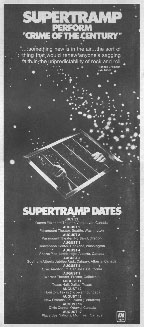![]()
  |

Crime of the Century
Supertramp
A&M 3647
Released: October 1974
Chart Peak: #38
Weeks Charted: 76
Certified Gold: 8/2/77
 Virtually every track on this album seems to last twice as long as the actual music warrants, a vastly disproportionate of needle time seems to be devoted to pauses which, one guesses, the 'Tramps want us to find rivetingly portentous, but in fact are only tiresome. Because, in addition to appreciable instrumental dexterity, they seem to possess the rare ability to harmonize handsomely: One is rendered sleepless by the desire to lock them in a room with the first few Beatles albums until they're convinced that it's possible to be as dynamic and atmospheric in two-and-a-half minutes as in five.
Virtually every track on this album seems to last twice as long as the actual music warrants, a vastly disproportionate of needle time seems to be devoted to pauses which, one guesses, the 'Tramps want us to find rivetingly portentous, but in fact are only tiresome. Because, in addition to appreciable instrumental dexterity, they seem to possess the rare ability to harmonize handsomely: One is rendered sleepless by the desire to lock them in a room with the first few Beatles albums until they're convinced that it's possible to be as dynamic and atmospheric in two-and-a-half minutes as in five.
The overlapping themes of this at least very nicely produced album seem to be the repression of individuality and the world's intolerance of eccentricity, although one is hard put to infer as much from the generally graceless and not awfully provocative lyrics which, to put it as civilly as possible, seem to be something less than the long suit of 'Tramp tunesmiths Hodgson and Davies. Should their option be picked up, they ought, in addition to instructing their tape-op to allow no single track to last longer than 200 seconds, concentrate more on melody.
- John Mendelsohn, Rolling Stone, 4/10/75.
 Click image for larger view. |
Rather old mix of rock in the more traditional vein, strong electronic and horn sounds and same humorous moments from British quintet who can rock with the best or move through quiet harmonies. Best material seems to be the up-tempo things that allow the band a chance to rock, but it all works well. Not really an AM group in the "singles" sense of the word, but one that should find a quick home on any station willing to play some LP cuts.
- Billboard, 1974.
- Robert Christgau, Christgau's Record Guide, 1981.
Crime of the Century must rival Pink Floyd's Dark Side of the Moon for sales on the grounds of sound quality as well as musical strength. Supertramp's carefully crafted productions, bursting with detail and sound effects, truly come to life through CD.
Always a dynamic, detailed sound from vinyl, Crime discloses a wealth of intricate detail in the rich woodwind scoring and percussion. Most impressive however are the dynamic swings and crescendos in "School" with its vividly recorded piano lead and growling bass line. Similarly the punctuated electric piano intro to "Bloody Well Right."
The depth created by the playground "atmosphere" in "School" and the locomotive sound effects in "Rudy" are startingly clear. Voices and piano are slightly dry but this 1974 recording stands up to the closest scrutiny with a particularly fine treble and gutsy guitar sound. Crime deserves to match its million selling LP status in CD format.
- David Prakel, Rock 'n' Roll on Compact Disc, 1987.
With Crime of the Century, Supertramp established themselves as one of the handful of progressive rock acts that could sell albums and have hit singles. Stripping away the longwinded excesses of their first two albums, Crime of the Century featured tighter, more melodic songs, as evidenced by the singles "Bloody Well Right" and "Dreamer." * * * *
- Stephen Thomas Erlewine , The All-Music Guide to Rock, 1995.
Crime of the Century is worth owning if only for the piano solo on "School." This is the album where the band first put its sound together, and remains its best, with other highlights such as "Bloody Well Right" and "Dreamer." * * * *
- Gary Plochinski, Musichound Rock: The Essential Album Guide, 1996.
By the time Supertramp convened for their third album, the writing was on the wall. The whole band had quit after 1971's Indelibly Stamped, leaving the creative hub of Roger Hodgson and Rick Davies needing to regroup and write a masterpiece to save their A&M recording contract. This was especially important after Dutch millionaire benefactor Stanley Miesegaes also abandoned ship, having written off $90,000 worth of loans. Supertramp had been so broke they had even backed Chuck Berry for cash!
Fortunately the fruits of a mammoth writing session in a Somerset farmhouse from November 1973 to Februrary 1974 -- Crime of the Century -- changed the picture entirely. The tuneful, tightly played songs, pristine clarity of sound (courtesy of Ken Scott, who had worked on Bowie's Ziggy Stardust), and myriad imaginative sound effects, helped create an album that Sounds magazine likened to "Genesis, The Beach Boys...a smattering of [Pink] Floyd." The success of intense, keyboard-driven single "Dreamer" helped Crime... pay by sending the album all the way to UK No. 4.
The distinctive cover, designed (but not produced) as a gatefold sleeve, was created by graphic artist Paul Wakefield after exposure to the completed album. Reminiscent of Traffic's Shootout At The Fantasy Factory, its "prison bars" have become an iconic image.
Supertramp had arrived in the spotlight long enough before punk to allow them to launch a career, even if post-new wave this was to be sustained mostly abroad. Crime... was its foundation, and provided the backbone to their set for many years.
- Michael Heatley, 1001 Albums You Must Hear Before You Die, 2005.
![]() Reader's Comments
Reader's Comments
No comments so far, be the first to comment.